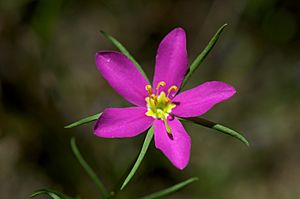Pelton’s rose gentian facts for kids
Quick facts for kids Pelton's rose gentian |
|
|---|---|
 |
|
| Conservation status | |
| Scientific classification | |
| Genus: |
Sabatia
|
| Species: |
arkansana
|
Pelton's rose gentian, also known as Sabatia arkansana, is a beautiful plant. It's an annual, meaning it lives for only one year. This plant belongs to the gentian family.
It was first found in 2001 in Saline County, Arkansas. A retired mechanic named John Pelton discovered it. He was an amateur photographer and loved nature. This special flower grows in unique open areas called glades in the Ouachita Mountains.
Pelton's rose gentian is very rare. It is only found in two places in Saline County. Because of new buildings nearby and a lack of natural fires, it is in great danger. In the summer, this plant shows off its lovely rose-purple flowers.
Contents
What Pelton's Rose Gentian Looks Like
This plant is an annual plant, which means it completes its life cycle in one year. It usually grows to be about 12 centimeters (about 5 inches) tall.
- Leaves: The leaves grow in pairs opposite each other on the stem. They are shaped like a spear, about 5 to 15 millimeters long. This is about 0.2 to 0.6 inches. They are also 2 to 3 millimeters wide, or about 0.08 to 0.12 inches.
- Flowers: The flowers are about 3.5 centimeters (1.4 inches) wide. They have five petals that are purplish-pink. The center of the flower is a pale yellow. There are also five yellow stamens, which are the parts that hold pollen.
- Fruit: After the flower, a capsule forms. This is a type of fruit that holds the seeds. It is about 1 centimeter (0.4 inches) long.
How Pelton's Rose Gentian is Different
Pelton's rose gentian looks a lot like another plant called Sabatia campestris. They often grow in the same places.
However, you can tell them apart by a few things:
- Pelton's rose gentian is usually smaller.
- Its flowers are a darker pink.
- The petals of its flowers are more rounded.
- It prefers to grow in wetter spots.
Discovery and Naming of the Plant
John Pelton, a nature photographer, found Sabatia arkansana in 2001. He found it near a town called Owensville. At first, he didn't know he had found a new plant. He showed it to Theo Witsell, a student studying plants. Theo was working on a project about the plants of Arkansas.
John also collected samples of Sabatia campestris from the same spot. All the plant books they checked said both plants were S. campestris. But John and Theo could clearly see differences between them.
Later, Theo Witsell and John Pringle found more of Pelton's rose gentian. John Pringle was a botanist, a scientist who studies plants. They found it while looking for another rare plant near Bauxite.
Theo compared his plant samples with many S. campestris samples. He did this at the Missouri Botanical Garden. He confirmed that they were indeed different plants. Then, the samples were sent to John Pringle. He officially described the new species and gave it a scientific name.
The scientists wanted to name the plant after John Pelton. But he said no. So, they chose the name arkansana because the plant is only found in Arkansas. Even though he didn't want his name in the scientific name, they suggested the common name "Pelton's rose-gentian" to honor him.
Where Pelton's Rose Gentian Lives
Sabatia arkansana only grows in special places. These are called shale and igneous glades. These areas get very wet in winter. But they become dry from summer through fall.
Within these unique spots, the plant grows in flat areas. These are often along the edges of small streams. These streams often dry up during the hot months. You might also find it near seeping springs, which are places where water slowly comes out of the ground.
Since the plant is an annual, its numbers change each year. At the first place it was found, between 200 and over 1000 plants were counted from 2001 to 2004. The other known location showed similar numbers. Scientists looked for more of these plants in nearby counties in 2003 and 2004. They searched in Pulaski County, Garland County, and Montgomery County. But they did not find any other places where Pelton's rose gentian grows.


